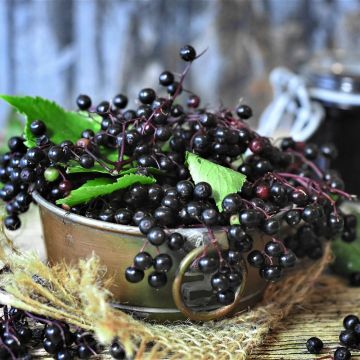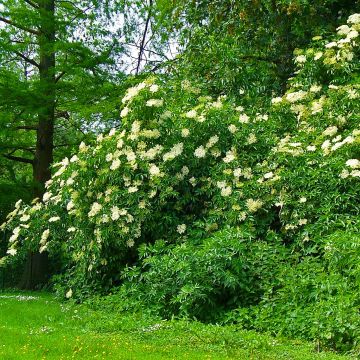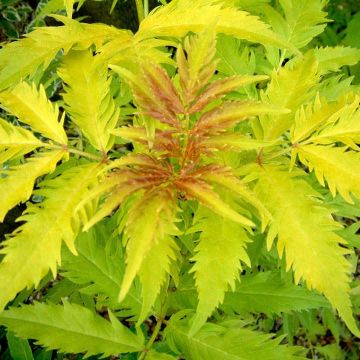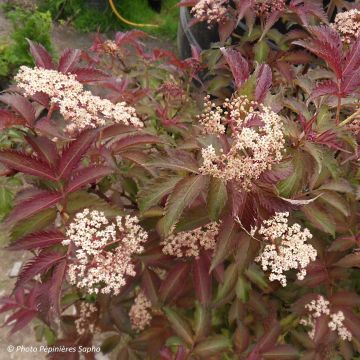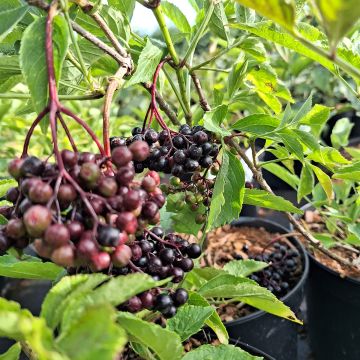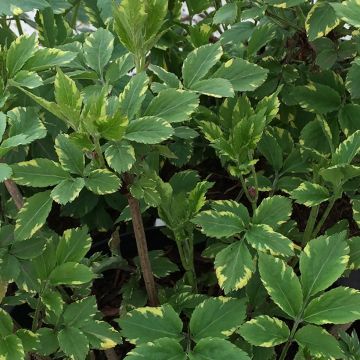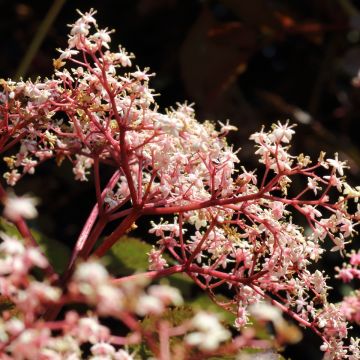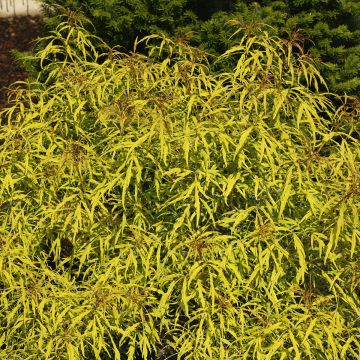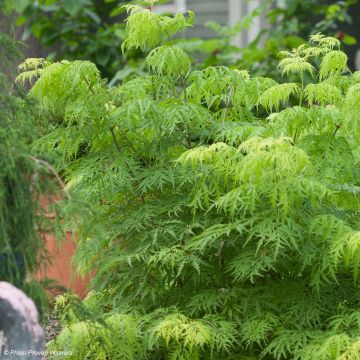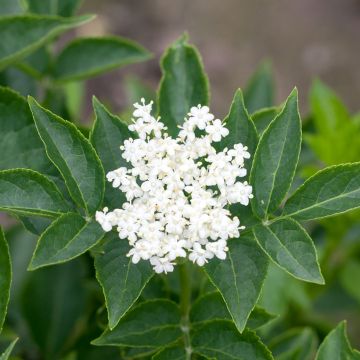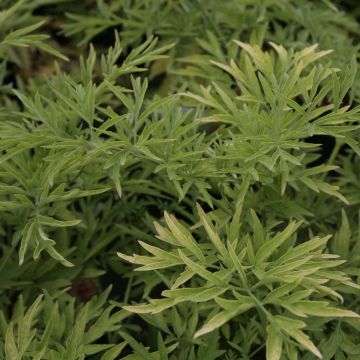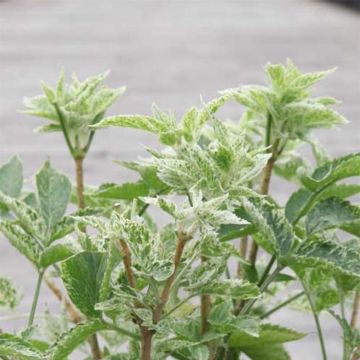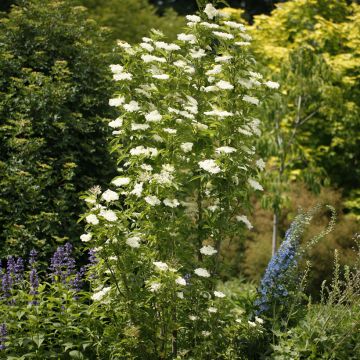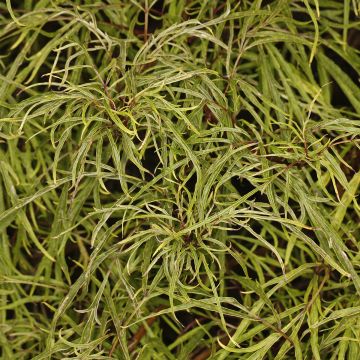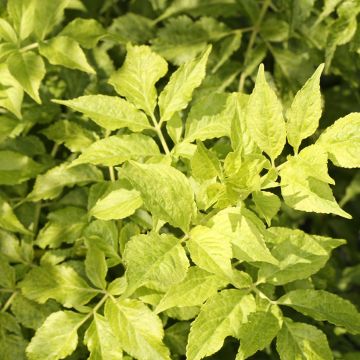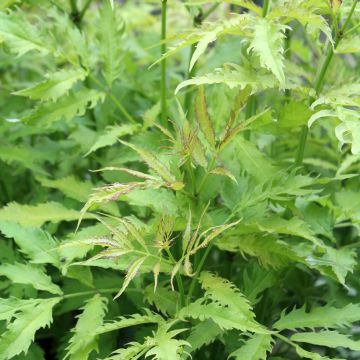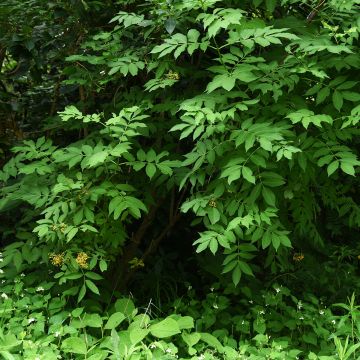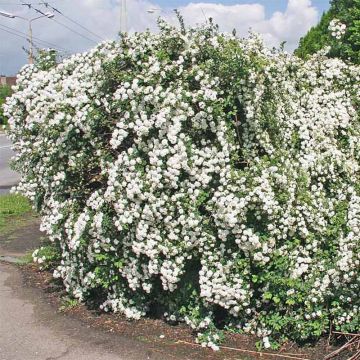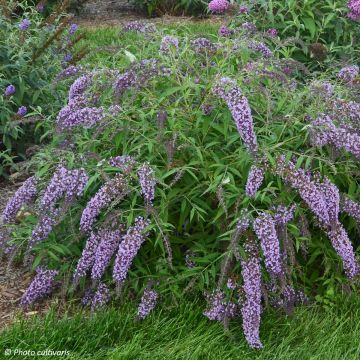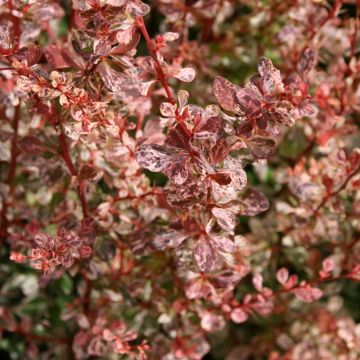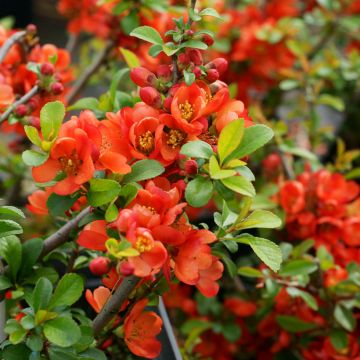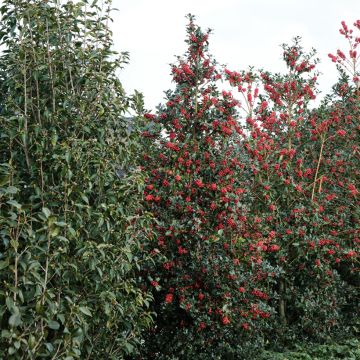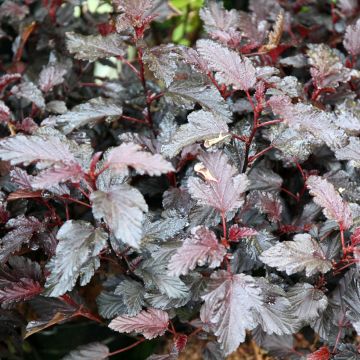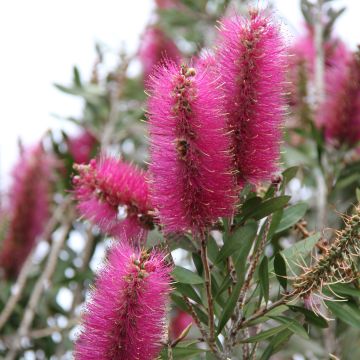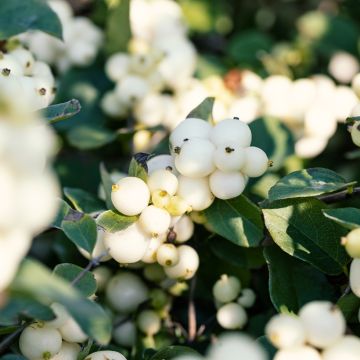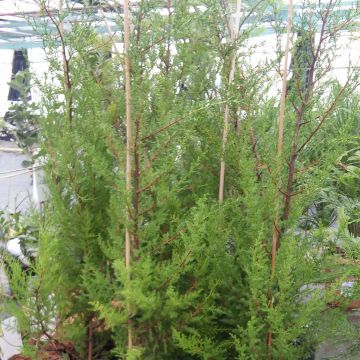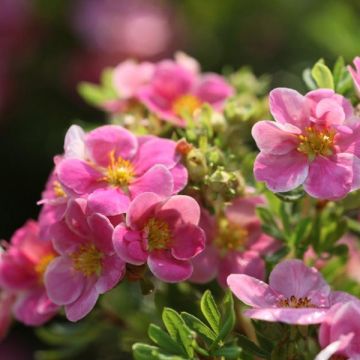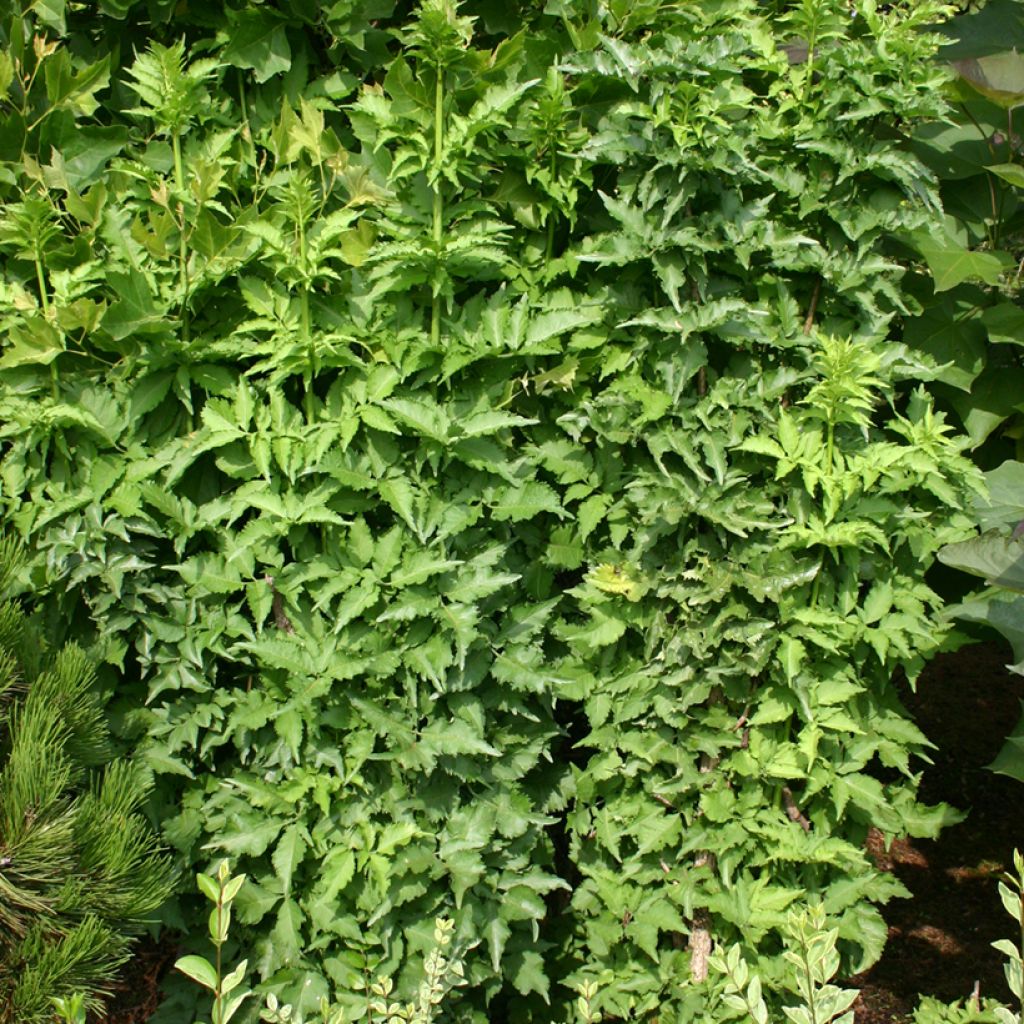

Sambucus nigra Pyramidalis - Elder
Sambucus nigra Pyramidalis - Elder
Sambucus nigra Pyramidalis
Elder, Black Elder, European Elder, Elderberry
Why not try an alternative variety in stock?
View all →This plant carries a 24 months recovery warranty
More information
We guarantee the quality of our plants for a full growing cycle, and will replace at our expense any plant that fails to recover under normal climatic and planting conditions.
From €5.90 for pickup delivery and €6.90 for home delivery
Express home delivery from €8.90.
Delivery to Corse prohibited: UE law prohibits the import of this plant from mainland France to Corse as part of the fight against Xylella fastidiosa. Please accept our sincere apologies.
More information
Does this plant fit my garden?
Set up your Plantfit profile →
Description
Sambucus nigra 'Pyramidalis', also known as Sambucus nigra var. fastigiata, is a rather unusual black elderberry with its narrow upright habit and "compressed" foliage. Contrary to what its name suggests, this cultivar from Poland forms a particularly dense column-like shape during the growing season. In winter, the shrub displays its thick vertical branches and fissured bark. Its white umbel flowers in June add to its charm. Hardy and easy to grow in ordinary soil, this elderberry is best planted as a prominent specimen.
Sambucus nigra 'Pyramidalis' is the name given to two fastigiate forms of the black elderberry. Both have a very upright habit. The first 'Pyramidalis' only differs from the species by its vertical branches that are close to the trunk. The second also has very short internodes, which contribute to the particularly "compressed" appearance of the foliage. The 'Pyramidalis' cultivar distributed by Polish nurseries seems to be the second form.
The 'Pyramidalis' black elderberry is rare in cultivation and deserves to be planted more widely. This variety was found in Germany and introduced into commerce in 1865. It belongs to the Caprifoliaceae, Adoxaceae, or Viburnaceae family, depending on the classification. It is an upright, columnar and rather narrow shrub. It grows slightly slower than the wild species and can reach 3 to 4 m in height and up to 1 m in width. All branches of this cultivar point vertically upwards and are sparsely branched. Some branches may grow only from a single upper bud. This type of growth is responsible for the bush's very unusual appearance. The dark green leaves have the same structure as those of the species, with 5 to 7 ovate and toothed leaflets, but they are slightly smaller and arranged more densely on the branches. After the leaves fall in autumn, the rather loose structure of this shrub can be seen, consisting of simple, straight, and thick branches. Flowering occurs in May-June, depending on the climate. The flowers form flat and rounded cymes, measuring 8 to 12 cm in diameter, slightly smaller than those of the species. Pollinated by bees, these flowers produce small black drupes. The flowers and fruits have medicinal uses and are used in the production of liqueurs, jams, preserves, etc. This shrub is resistant to the coldest winters.
This variety of black elderberry 'Pyramidalis' is primarily grown for its decorative value. It requires a fertile, rich, and alkaline soil. It is resistant to pollution and can be planted in small urban gardens. It can be planted as a solitary specimen, in small groups, or as a hedge to create a green screen. It can also be showcased near an entrance, window, or along a path. It can be paired, for example, with dark foliage plants such as the black elderberry 'Black Beauty', the sand cherry 'Prunus cistena', 'Weigelia florida 'Alexandra'', or the ninebark 'Physocarpus opulifolius 'Red Baron''. To adorn its base, choose dwarf conifers with a creeping habit (Juniperus communis 'Repanda', Juniperus squamata 'Blue Carpet'...)
In the kitchen: the flowers can be prepared as fritters or syrup by macerating them in sugar. The flower buds pickled in vinegar can be used to enhance salads, and the berries can be consumed as juice, jellies, or jams, or made into wine. They add a pleasant fragrance to apple cakes. Only the flowers and berries without their petioles are edible; the rest of the plant can be toxic.
In the garden: elderberry leaves are known to accelerate compost decomposition. Black elderberry leaf infusion is useful in organic gardening to combat mildew and aphid or rodent attacks: soak 1 kg of leaves in 10 L of water for a few days and spray as needed. It can also be planted in an orchard, where it attracts insect-eating birds.
Report an error about the product description
Plant habit
Flowering
Foliage
Botanical data
Sambucus
nigra
Pyramidalis
Adoxaceae (Viburnaceae)
Elder, Black Elder, European Elder, Elderberry
Sambucus nigra var. fastigiata
Cultivar or hybrid
Other Sambucus - Elder tree
Planting and care
The 'Pyramidalis' elderberry should be planted in spring or autumn, in loose and deep soil, fairly rich, preferably limestone, not too dry in summer. It requires little maintenance. Plant it in a sunny or semi-shaded location. At planting, use a mix of half potting compost/half garden soil. To promote flowering, prune the old branches to rejuvenate them and cut back the young branches by a third in late winter.
Planting period
Intended location
Care
This item has not been reviewed yet - be the first to leave a review about it.
Hedge shrubs
Haven't found what you were looking for?
Hardiness is the lowest winter temperature a plant can endure without suffering serious damage or even dying. However, hardiness is affected by location (a sheltered area, such as a patio), protection (winter cover) and soil type (hardiness is improved by well-drained soil).

Photo Sharing Terms & Conditions
In order to encourage gardeners to interact and share their experiences, Promesse de fleurs offers various media enabling content to be uploaded onto its Site - in particular via the ‘Photo sharing’ module.
The User agrees to refrain from:
- Posting any content that is illegal, prejudicial, insulting, racist, inciteful to hatred, revisionist, contrary to public decency, that infringes on privacy or on the privacy rights of third parties, in particular the publicity rights of persons and goods, intellectual property rights, or the right to privacy.
- Submitting content on behalf of a third party;
- Impersonate the identity of a third party and/or publish any personal information about a third party;
In general, the User undertakes to refrain from any unethical behaviour.
All Content (in particular text, comments, files, images, photos, videos, creative works, etc.), which may be subject to property or intellectual property rights, image or other private rights, shall remain the property of the User, subject to the limited rights granted by the terms of the licence granted by Promesse de fleurs as stated below. Users are at liberty to publish or not to publish such Content on the Site, notably via the ‘Photo Sharing’ facility, and accept that this Content shall be made public and freely accessible, notably on the Internet.
Users further acknowledge, undertake to have ,and guarantee that they hold all necessary rights and permissions to publish such material on the Site, in particular with regard to the legislation in force pertaining to any privacy, property, intellectual property, image, or contractual rights, or rights of any other nature. By publishing such Content on the Site, Users acknowledge accepting full liability as publishers of the Content within the meaning of the law, and grant Promesse de fleurs, free of charge, an inclusive, worldwide licence for the said Content for the entire duration of its publication, including all reproduction, representation, up/downloading, displaying, performing, transmission, and storage rights.
Users also grant permission for their name to be linked to the Content and accept that this link may not always be made available.
By engaging in posting material, Users consent to their Content becoming automatically accessible on the Internet, in particular on other sites and/or blogs and/or web pages of the Promesse de fleurs site, including in particular social pages and the Promesse de fleurs catalogue.
Users may secure the removal of entrusted content free of charge by issuing a simple request via our contact form.
The flowering period indicated on our website applies to countries and regions located in USDA zone 8 (France, the United Kingdom, Ireland, the Netherlands, etc.)
It will vary according to where you live:
- In zones 9 to 10 (Italy, Spain, Greece, etc.), flowering will occur about 2 to 4 weeks earlier.
- In zones 6 to 7 (Germany, Poland, Slovenia, and lower mountainous regions), flowering will be delayed by 2 to 3 weeks.
- In zone 5 (Central Europe, Scandinavia), blooming will be delayed by 3 to 5 weeks.
In temperate climates, pruning of spring-flowering shrubs (forsythia, spireas, etc.) should be done just after flowering.
Pruning of summer-flowering shrubs (Indian Lilac, Perovskia, etc.) can be done in winter or spring.
In cold regions as well as with frost-sensitive plants, avoid pruning too early when severe frosts may still occur.
The planting period indicated on our website applies to countries and regions located in USDA zone 8 (France, United Kingdom, Ireland, Netherlands).
It will vary according to where you live:
- In Mediterranean zones (Marseille, Madrid, Milan, etc.), autumn and winter are the best planting periods.
- In continental zones (Strasbourg, Munich, Vienna, etc.), delay planting by 2 to 3 weeks in spring and bring it forward by 2 to 4 weeks in autumn.
- In mountainous regions (the Alps, Pyrenees, Carpathians, etc.), it is best to plant in late spring (May-June) or late summer (August-September).
The harvesting period indicated on our website applies to countries and regions in USDA zone 8 (France, England, Ireland, the Netherlands).
In colder areas (Scandinavia, Poland, Austria...) fruit and vegetable harvests are likely to be delayed by 3-4 weeks.
In warmer areas (Italy, Spain, Greece, etc.), harvesting will probably take place earlier, depending on weather conditions.
The sowing periods indicated on our website apply to countries and regions within USDA Zone 8 (France, UK, Ireland, Netherlands).
In colder areas (Scandinavia, Poland, Austria...), delay any outdoor sowing by 3-4 weeks, or sow under glass.
In warmer climes (Italy, Spain, Greece, etc.), bring outdoor sowing forward by a few weeks.

































